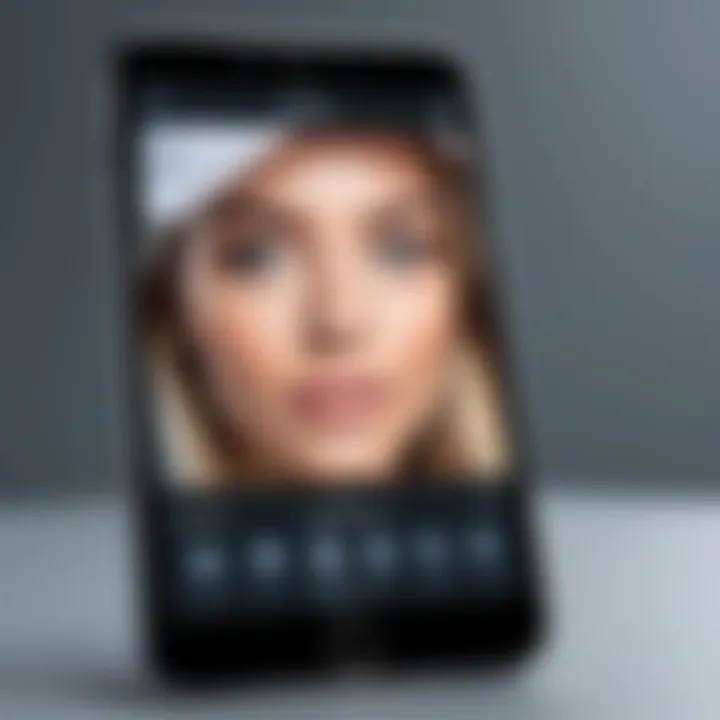Transform Your Smartphone into a Powerful Webcam


Intro
The technological landscape is shifting rapidly. With increasing need for high-quality video communication, many professionals turn to their smartphones as versatile tools. This guide delves into the intricacies of using a smartphone as a webcam, presenting a step-by-step approach for those who seek to enhance their video streaming capabilities. The method not only provides a cost-effective solution but also leverages existing hardware that most individuals own.
Features Overview
Key Specifications
When discussing smartphone webcams, it is crucial to focus on specific features that impact performance. Nowadays, smartphones come equipped with impressive camera specifications. Features such as resolution, autofocus, and aperture size are significant. Typically, a smartphone with at least 1080p resolution ensures clear-quality images. Moreover, optical image stabilization helps reduce video shakiness, crucial for maintaining professionalism in streams.
Unique Selling Points
Using a smartphone as a webcam delivers several advantages over traditional webcams. Firstly, smartphones often have superior camera sensors. Secondly, they provide flexibility and portability. You can easily reposition them when needed, although versatile mounting solutions exist. Finally, integrating with existing video streaming applications is often straightforward, due to modern software compatibility.
"Smartphones can provide clearer images than most dedicated webcams, reshaping how video communication is viewed."
Performance Analysis
Benchmarking Results
To gauge performance comprehensively, we can conduct benchmarking tests between traditional webcams and smartphones. The tests generally show that mid-range smartphones often outshine consumer-grade webcams in video quality. Latency is another crucial aspect. Smartphones designed for high-speed processing tend to exhibit lower delays during transmission.
Real-world Scenarios
In common use cases, many professionals have found their smartphones to meet their streaming needs perfectly. For example, educators and trainers utilize this setup for remote lessons. The result has been enhanced engagement through superior video quality. Likewise, tech enthusiasts who game often harness their smartphones for streaming to platforms like Twitch, gaining clarity and sharp visuals that were previously unattainable with standard webcams.
Foreword to Using Smartphones as Webcams
In today's world, the utilization of smartphones has extended far beyond their original purpose as communication devices. This guide will explore the significant role that smartphones can play as webcams. With the rise of remote work and virtual communication, many people search for solutions that are both cost-effective and practical. Transforming a smartphone into a webcam enables users to leverage a device they already own—delivering higher quality video without needing to purchase a separate camera.
The shift towards utilizing smartphones as webcams can be attributed to several reasons. As technology advances, smartphones now contain powerful cameras and processing capabilities that often rival traditional webcams. Users are finding that they can achieve improved image quality and functionality simply by repurposing existing hardware. This not only saves money but also enhances convenience, allowing individuals to quickly set up video calling capabilities wherever they are.
Moreover, the integration of various applications and tools makes the conversion process much easier. Specific software solutions provide guidance on this transformation, opening a wide array of options for those looking to enhance their video streaming.
In essence, embracing smartphones as webcams reflects current trends in video communication. This article will delve into the rationale behind this shift and examine it comprehensively. The exploration of practical use cases, technical requirements, and compatibility considerations will aid readers in making informed decisions that suit their particular needs.
Rationale Behind the Shift
The movement towards using smartphones as webcams arises from a combination of technological evolution and changing work dynamics. High-definition cameras included in smartphones have significantly improved in quality, making them viable options for video communication. Many individuals may not have considered repurposing their smartphone until the onset of the pandemic prompted a more remote-oriented lifestyle. Such a development underscored the necessity for reliable, high-quality video capabilities.
From a practical stance, users no longer need to invest in expensive equipment. Instead, they can use their smartphones, which they already carry, limiting the need for additional accessories. This shift aligns with overall trends in technology, where efficiency and portability are prized attributes.
Current Trends in Video Communication
Video communication has transformed dramatically in recent years. The rise of platforms such as Zoom, Microsoft Teams, and Google Meet has changed how we interact, both personally and professionally. As remote interactions have become commonplace, so too have expectations for video quality and reliability.
Organizations and individuals seek ways to enhance their online presence and make impactful connections during video calls. Utilizing smartphones offers distinct advantages that traditional webcams struggle to replicate. Notably, smartphones support superior autofocus and low-light performance, enabling viewers to see clearer images regardless of conditions.
Additionally, as the need for video content grows, many are exploring different forms of communication, including streaming and vlogging. Smartphones aid in creating versatile setups; one can switch between video conferencing and content creation with minimal adjustment.
In the subsequent sections, we will adequately discuss the technical requirements and software necessary for this venture. Delving deeper into compatibility considerations will empower users to optimize their setups for various needs.
Technical Requirements
Understanding the technical requirements for utilizing a smartphone as a webcam is essential for achieving optimal performance and functionality. The integration of mobile technology into video communication has redefined traditional concepts of webcam usage. As professionals increasingly rely on remote communication, knowing the specific technical elements can provide a significant advantage. This section will explore critical smartphone specifications and the various options for connecting devices, whether through wired or wireless solutions.
Smartphone Specifications
When considering the use of a smartphone as a webcam, certain specifications become particularly important. First, the camera resolution plays a crucial role. A higher resolution results in clearer and sharper images. Most recent smartphone models come equipped with advanced camera systems that can deliver quality comparable to dedicated webcams.
In addition to camera capabilities, the processing power of the smartphone matters. An efficient processor enhances video encoding and reduces latency, which can significantly impact the user experience during live sessions. Furthermore, adequate RAM is also vital. Insufficient memory can lead to lags or crashes during video streaming.
Another aspect to consider is connectivity options. Smartphones with Bluetooth 5.0 or Wi-Fi 6 support offer faster and more stable connections, minimizing interruptions during use.
Key Specifications to Check:


- Camera resolution (1080p or higher is preferred)
- Processor (look for A-series for iPhones or Snapdragon for Android devices)
- RAM (at least 4GB recommended)
- Supported connectivity options (Bluetooth and Wi-Fi standards)
Connecting Devices: Wired vs. Wireless
Now, let's delve into the methods of connecting your smartphone to your computer or other devices. This is a crucial step in establishing a reliable webcam setup. The two primary options are wired connections, utilizing USB cables, and wireless connections, often requiring a stable Wi-Fi network or Bluetooth.
Wired Connections
Using a wired connection generally offers greater stability and less latency. This method allows the smartphone to transmit data directly to the computer without interference from external factors, such as Wi-Fi signal strength. To set up a wired connection, a simple USB cable can be used, and specific software applications, like DroidCam or EpocCam, can recognize the smartphone as a webcam.
Wireless Connections
On the other hand, wireless connections offer flexibility and mobility, allowing users to position their smartphones freely within a designated area. The setup process for wireless connections may vary. However, it typically involves connecting both devices to the same network and utilizing relevant software to facilitate communication. While wireless connections can introduce some latency, advances in technology have made this less of an issue than before.
Choosing between wired and wireless will depend on your specific needs and environment. If stability is your primary concern, wired connections are advisable; however, for mobility, a wireless setup could be more beneficial.
Understanding these technical requirements lays the groundwork for successfully converting your smartphone into a webcam. With appropriate specifications and connection methods, users can enhance their video communication experience and leverage the full potential of their devices.
Software Solutions for Webcam Functionality
Smartphones have evolved significantly over the years, and their capabilities extend beyond just calling or messaging. Software solutions are crucial for transforming a smartphone into a functional webcam. These applications bridge the hardware of your smartphone with various video communication platforms, enabling seamless video feeds. Understanding different software solutions can empower users to make informed choices based on their specific needs and environment.
When employing your smartphone as a webcam, several factors can influence the experience. These include user-friendliness, connection stability, and the specific features provided by the application. Selecting the right software means considering these factors to ensure a smooth transition from a traditional webcam setup.
Popular Applications and Tools
EpocCam
EpocCam is a popular choice for many users due to its versatility and ease of use. This application allows smartphones to connect as webcams for both Windows and Mac operating systems, supporting high-definition video streams. One of its key characteristics is its compatibility with various video conferencing tools like Zoom, Skype, and Microsoft Teams.
A unique feature of EpocCam is its support for both wired and wireless connections, which offers flexibility depending on usage scenarios. However, the free version imposes limitations on video resolution and some functionalities, making the paid version a more appealing option for professionals seeking higher quality.
iVCam
iVCam stands out as another strong contender for converting smartphones into webcams. This application not only offers clear video streaming but also has various settings for adjusting video resolution, frame rates, and even audio inputs. Its key characteristic is its ability to function with minimal configuration, ideal for users who want quick setups without extensive technical knowledge.
A unique feature of iVCam is its capability to record video while using the phone as a webcam, which can be beneficial for content creators. However, users have noted that the application consumes considerable battery power, which may be a disadvantage during extended use.
DroidCam
DroidCam offers a practical solution for those looking to use their smartphone as a webcam without significant investment. This application is available for both mobile devices and computers, facilitating easy connections. Its key characteristic is the inclusion of an option for audio input, enhancing the overall communication experience.
What differs DroidCam from other applications is its provision of a free version, which, while limited, can serve as a decent introduction to using smartphone webcams. However, users may experience instability in video quality during poor network conditions, which can impact user experience.
Setting Up Webcam Software
Setting up software for webcam functionality involves straightforward steps. First, download the chosen application from the App Store or Google Play. Install the corresponding client on the PC or Mac. Depending on the application, connect your smartphone using either a USB cable or via Wi-Fi. This connection method will often dictate the configuration process. For wired connections, you may need to enable USB debugging in your phone's settings. After this, follow the prompts provided by the application to finalize setup. Typically, once configured, the software will recognize the mobile device as a webcam, allowing immediate use in your preferred video communication platform.
Compatibility Considerations
The significance of compatibility considerations in utilizing a smartphone as a webcam cannot be overstated. Ensuring that the devices and software involved work smoothly together enhances the overall user experience. Compatibility affects everything from setup ease to performance effectiveness. Understanding these factors is key for professionals seeking reliability in their video communication tools.
Operating System Compatibility
Windows
Windows operating system is a dominant platform, holding a considerable share of the market. Its significance in transforming your smartphone into a webcam lies in its broad support for various applications. Most webcam software have dedicated versions for Windows, making it a prime choice for users.
One notable feature of Windows is its flexibility, allowing the installation of multiple drivers. These drivers can adapt the connection type used by your smartphone, whether wired or wireless. However, some users may face issues with driver incompatibility, which can hinder performance.
Mac OS
Mac OS stands out for its stability and ease of use. This operating system supports fewer applications compared to Windows, which can affect the options available. Despite this limitation, the existing software is often highly optimized to work seamlessly on Mac devices.
A unique aspect of Mac OS is its consistent performance across different hardware configurations. Users often find that setting up their smartphone as a webcam on Mac is straightforward, though certain applications might not perform as efficiently as on Windows.
Linux
Linux represents a unique proposition, appealing to a smaller yet dedicated user base. The open-source nature of Linux allows developers to create custom software solutions for various needs. This flexibility contributes well to the objective of transforming a smartphone into a webcam.


However, the key characteristic of Linux is also its dependence on community support. This support can sometimes lag behind, leading to potential difficulties in finding reliable webcam software. While Linux users may enjoy a tailored experience, they might encounter more challenges compared to their Windows or Mac counterparts.
Hardware Dependencies
The hardware dependencies are crucial when considering how well a smartphone will work as a webcam. Factors such as camera quality, processing power, and connectivity options all contribute to the overall performance.
- Camera Quality: The resolution and capabilities of the smartphone's camera are significant. Higher resolution cameras will provide better image quality during video streams.
- Processing Power: A smartphone with adequate processing capabilities will handle video encoding and transmission more efficiently.
- Connectivity Options: Smartphones that offer varied connectivity options (USB, Wi-Fi) provide flexibility in setup. Each method has its advantages, so the choice of connection can affect performance quality.
Quality and Performance Factors
Quality and performance are crucial components when utilizing a smartphone as a webcam. A high-quality video feed is essential for effective communication, whether in professional meetings or content creation. Performance factors, such as latency and connection stability, directly affect the user experience. By understanding these elements, users can better prepare their setups for optimal results.
Image and Video Quality
Image and video quality are paramount when using a smartphone as a webcam. Most modern smartphones are equipped with advanced cameras, often surpassing traditional webcams. High-resolution video enhances the clarity of the image, making it easier for viewers to engage with the content. Key factors affecting image quality include:
- Camera Specifications: The megapixel count and the sensor quality of the smartphone camera significantly affect the video feed. Higher megapixels result in clearer images, while better sensors perform well in low-light conditions.
- Lighting Conditions: Adequate lighting is crucial for high-quality video. Natural light is preferable, but supplementary lighting can improve video quality when used correctly.
- Resolution Settings: Different software allows users to adjust resolution settings. Higher resolution generally yields better quality but may require more bandwidth.
Optimizing these factors can lead to an effective video display that enhances communication and presentation. Selecting the right smartphone and ensuring adequate lighting are simple yet effective ways to elevate the overall video experience.
Latency and Connection Stability
Latency and connection stability represent vital performance factors, especially for real-time communication. Latency refers to the delay between the video feed being captured and displayed. High latency can disrupt conversations and make interactions feel unnatural.
- Network Type: The choice between wired and wireless connections influences latency. Wired connections, such as USB, typically offer lower latency compared to wireless connections, which may face interference or signal degradation.
- Network Bandwidth: Sufficient bandwidth is necessary for streaming, affecting both latency and video quality. Users must ensure they have adequate internet speeds to support the chosen resolution.
- Device Compatibility: Compatibility between the smartphone and the software can affect connection stability. Using well-known applications like EpocCam or DroidCam can help mitigate connection issues.
High latency and unstable connections can lead to frustrating experiences during virtual meetings. Taking steps to improve these aspects is essential for professional settings.
Understanding these performance factors is imperative. By addressing image quality, latency, and connection stability, users can fully leverage their smartphones' capabilities as webcams. A thoughtful approach to these elements can significantly improve video conferencing experiences.
Practical Use Cases
The use of smartphones as webcams extends beyond mere novelty; it addresses practical needs in various scenarios. The advent of remote work and increased digital communication demands have highlighted the importance of having reliable video streaming options. Utilizing smartphones in these contexts offers various advantages, such as cost-efficiency, versatility, and user-friendly operation. Each scenario presents unique benefits, considerations, and potential drawbacks that deserve examination.
Remote Work and Virtual Meetings
In the era of telecommuting, video conferencing has become a staple in maintaining professional relationships. Smartphones can serve as effective webcams, offering several distinct advantages:
- Accessibility: Most professionals already own a smartphone. Thus, they can harness existing technology without needing to invest in dedicated equipment.
- Quality: Modern smartphones are equipped with high-resolution cameras, delivering superior image quality compared to many budget webcams. This aspect greatly enhances the visual experience for virtual meetings.
- Convenience: Setting up a smartphone as a webcam is typically straightforward. Users can quickly download required applications and connect to their computers with minimal effort.
However, there are considerations when using a smartphone for this purpose. Connection stability can vary, and appropriate lighting conditions are essential to ensure professional appearance during meetings. Regular usage may also lead to increased battery drain, necessitating access to a power source.
Content Creation and Streaming
The rise of content creators in various digital platforms underscores the value of quality video production. Smartphones provide both flexibility and capabilities that cater to diverse content creation needs. Here are key aspects of leveraging smartphones for streaming and video production:
- Portability: Smartphones offer a compact form factor, enabling creators to capture content on the go. This is a significant advantage over traditional webcams which often lack the mobility required for dynamic shoots.
- Functionality: A variety of apps are available that allow for advanced features such as multi-camera setups, filters, and real-time editing. These tools can enhance live streaming and video recording, resulting in a polished final product.
- Engagement: Platforms like Twitch and YouTube allow direct streaming from smartphones. This accessibility means creators can interact with their audience instantaneously, fostering a stronger connection with viewers.
Despite its advantages, challenges do exist. For example, smartphone microphones may not provide studio-quality sound, which could affect the overall production quality. Additionally, some applications may have limitations on streaming duration or require in-app purchases for additional features.
"Utilizing smartphones as webcams has changed the way we connect and create, catering to both professional environments and creative endeavors."
Overall, the integration of smartphones into remote work and content creation not only elevates user experience but also reflects a broader trend towards accessible technology solutions. Understanding the practical applications allows IT professionals to maximize their devices effectively.
Advantages of Using a Smartphone as a Webcam
Utilizing a smartphone as a webcam presents several advantages that can be particularly appealing to IT professionals and tech enthusiasts. This section outlines the key benefits of making this transition, emphasizing aspects such as cost-effectiveness, mobility, and the potential to enhance video communication overall.
Cost-Effectiveness
One of the most compelling reasons to consider using a smartphone as a webcam is the cost-effectiveness of this solution. Traditional webcams, especially those with high-quality specifications, can be quite expensive. In contrast, most people already own a smartphone equipped with a capable camera.
- Elimination of Extra Expenses: By repurposing an existing device, users avoid additional expenditures on dedicated webcam hardware. This is significant for budget-conscious professionals or those working in startups.
- Broadening Functionality: Smartphones often include additional features, such as video editing applications and remote control capabilities, further amplifying the value derived from the investment.
The versatility of a smartphone means it can serve many roles in addition to functioning as a webcam, making it a multi-functional tool worth leveraging.


Enhanced Mobility and Portability
In today’s fast-paced environment, the need for mobility and accessibility in video communication is paramount. Smartphones excel in this area.
- Lightweight Design: Much lighter than traditional webcams, smartphones can be easily transported or set up in various locations with minimal hassle. This is crucial for remote work and meetings that may take place in different environments.
- Flexible Usage: Whether you're at a coffee shop, a co-working space, or home, your smartphone allows for spontaneous video calls or streams without needing specific hardware. It provides the freedom to communicate effectively from virtually anywhere.
"Mobility is essential in the digital landscape, and a smartphone acting as a webcam ensures you're equipped at all times."
In summary, utilizing your smartphone as a webcam not only enhances cost-efficiency but also amplifies mobility, underscoring the advantages of modern technology in adapting to professional needs.
Challenges and Limitations
Understanding the challenges and limitations of utilizing a smartphone as a webcam is essential for IT professionals and tech enthusiasts. Despite the convenience and flexibility smartphones offer, they come with certain constraints that can affect performance and user experience. A thorough analysis of these factors can help users strategize better and mitigate issues that may arise during video calls or streaming sessions.
Technical Limitations of Smartphones
Smartphones designed primarily for communication have inherent hardware limitations that can become obstacles when used in a webcam capacity. Here are some notable technical limitations:
- Camera Quality: Although many smartphones have high-quality cameras, the sensor size is typically smaller than that of dedicated webcams. This can lead to inferior low-light performance and less detail in images.
- Processing Power: Real-time video processing requires substantial computational resources. The processing units in smartphones, while powerful, may not match the capabilities of high-end desktop computers designed for video streaming.
- Heat Generation: Prolonged use of smartphones as webcams can lead to overheating. The CPU and GPU generate heat during intensive tasks, which can throttle performance, causing lag or disconnections.
- Battery Drain: Continuous streaming can deplete the smartphone battery rapidly. If the device is not plugged into a charger, users may face interruptions due to power loss.
Thus, it is critical for users to evaluate their smartphone’s specifications against their needs when considering its use as a webcam.
User Experience Issues
While smartphones offer convenience, several user experience issues can limit their effectiveness as webcams. These factors can directly impact overall satisfaction:
- Interface Design: Many applications designed for webcam functionality might not be intuitive. Users can struggle with settings, leading to frustration during important calls.
- Connection Stability: Wireless connections are susceptible to interference and dropouts. A lagging connection can severely affect the quality of video streams.
- Limited Features: Unlike dedicated webcams, smartphones may lack features such as automated tracking or adjustable angles. This can limit usability in multi-person meetings or dynamic presentations.
- Compatibility Issues: Some smartphones may face compatibility challenges with popular platforms like Zoom, Microsoft Teams, or others. This could lead to unexpected interruptions or errors during use.
Despite the advantages, understanding these challenges and limitations ensures that users can proactively address issues. Options, like using external microphones or stabilizing devices, can enhance the experience. Addressing these elements is crucial for leveraging smartphones effectively within professional contexts.
Future Trends in Webcam Technology
Webcam technology is evolving rapidly, influenced by advancements in mobile communication and artificial intelligence. As smartphone usage increases for video broadcasting, understanding emerging trends becomes vital for IT professionals and tech enthusiasts. These trends will define the capabilities of future streaming setups and impact the way we interact in virtual environments.
Integration of 5G and Enhanced Connectivity
The roll-out of 5G networks is set to revolutionize how smartphones function as webcams. With increased bandwidth, low latency, and improved connection stability, 5G technology enables high-definition streaming with minimal interruption. This upgrade is particularly relevant for professionals who rely on real-time video communication, such as in remote work settings or online presentations.
Key benefits of 5G integration include:
- Higher Resolution Streaming: Users can expect to transmit video in 4K or higher resolution without the lag that was common on 4G networks.
- Increased User Capacity: More users can connect simultaneously without a noticeable drop in quality, enhancing collaborative efforts.
- Seamless Mobile Experience: Users can move freely while connected to the network, eliminating the need for wired connections.
"5G's impact on webcam technology will redefine the standards for video quality and connectivity in both professional and personal environments."
AI-Powered Features and Improvements
Artificial intelligence is further enhancing webcam functionality in smartphones. This comes through automatic adjustments and smarter processing capabilities. AI improvements include:
- Face Tracking: AI can help the camera follow the subject’s movements, keeping the user in focus during virtual meetings, which improves engagement and presentation quality.
- Background Blurring: Machine learning algorithms can distinguish between the background and the subject, allowing for cleaner presentations without the need for physical backdrops.
- Image Enhancement: AI tools can optimize video quality in various lighting conditions, ensuring that the output remains clear and appealing, regardless of the environment.
The incorporation of these technologies signifies a shift towards more intelligent and adaptive video solutions. This makes it easier for IT professionals to present themselves effectively, regardless of the setting.
Closure
This conclusion emphasizes the significance of leveraging smartphones as webcams, particularly in the continually evolving landscape of remote communication. The integration of smartphones in this capacity is not merely a trend; it reflects a fundamental change in how video communication can be conducted.
Summarizing Key Insights
Throughout this article, we have unpacked several critical aspects associated with utilizing a smartphone as a webcam. Key insights include the following:
- Cost-Effectiveness: Smartphones serve as a highly economical alternative to traditional webcams. Many people own high-quality smartphones, which reduces the need for additional purchases.
- Flexibility and Portability: The mobile nature of smartphones means that one can easily set up a video call or stream content from various locations. This is crucial for professionals who are always on the move.
- Enhanced Quality: Modern smartphones often feature advanced camera technology. This provides exceptional video and audio quality compared to many lower-end webcam options.
- Diverse Use Cases: The range of applications available allows users to adapt their smartphone's capabilities for various needs, from personal video chats to professional streaming or content creation.
Each of these points demonstrates how transforming a smartphone into a webcam opens up numerous advantages in practical scenarios.
Final Thoughts on Smartphone Usage in Professional Settings
As we reflect on the use of smartphones as webcams in professional environments, it becomes clear that this transition aligns with broader trends in technology and communication. With the rise of remote work, professionals must be equipped with tools that enhance their capabilities without compromising quality or efficiency.
In professional settings, utilizing a smartphone can facilitate smoother communications and more engaging presentations. It allows for a more personal touch when interacting with colleagues or clients, as many are already familiar with the interface of smartphones.
"The ability to use existing technology for a new purpose underscores adaptability in a fast-paced work environment."
It is essential for IT professionals and technology enthusiasts to embrace this shift, understanding the implications for workflow and productivity. With the continuous advancement of mobile technology, the potential for smartphones to dominate the webcam market will likely grow. The future points toward further convergence between mobile devices and traditional computing, making it an exciting area to explore.



